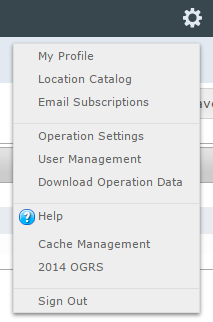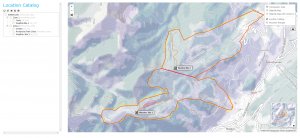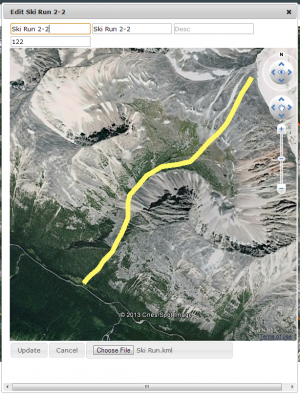Difference between revisions of "Editing locations in the location catalog"
(→Step-by-step description) |
(→Related documents) |
||
| Line 54: | Line 54: | ||
==Related documents== | ==Related documents== | ||
| − | * | + | * [[Adding locations to the location catalog]] |
| − | * | + | **[[Entering the geometry of a location using the available drawing tools]] |
| + | **[[Importing the geometry of a location from a KML file]] | ||
| + | * [[Deleting locations from the location catalog]] | ||
| + | * [[Creating a hierarchy among your locations]] | ||
| + | * [[Searching for a location in the location catalog]] | ||
==Functionality tested by== | ==Functionality tested by== | ||
Revision as of 20:17, 21 October 2013
| REQUIREMENTS | |
| Permission | Operation Administrator or higher |
| Connectivity | Online only |
This document describes how to edit locations in the location catalog of your operation.
Background
The ability to edit locations and delete obsolete location from your from the location tree of an operation should allow users to main a clean catalog of relevant location at all time. However, please note that the editing locations affects all observations that have ever been associated with the given location. For example, if you change the location of a weather site, all associated historic observations will be moved to the new location. Similarly, when you change the name of a ski run, all of the associate historic avalanche observation will then be associated with the new name of the ski run.
We recommend the following guidelines for the maintenance of your location catalog:
- Editing is appropriate for minor changes in the attributes (e.g., fixing of typos, name changes, minor adjustments of their geometries) of location that still represent the same piece of terrain. This approach will ensure that that time series (e.g., long-time observations at a weather site with a changing name) will be maintained.
- If the geometry of a location changes considerable, it would be better to delete the location and create a new location under the same name. This approach will ensure that all observations associated with this location are displayed at their appropriate locations.
Step-by-step description
| 1. | Select the Location Catalog from the administration menu (cog wheel) in the top left corner of the screen (Fig. 1). To have access to this menu item, you need to be either an operation administrator or a super user. | ||||
| 2. | This will get you to the location catalog screen of the application (Fig. 2). Please note that depending on your connectivity and the size of your location catalog, it might take a while to start Google Earth and load your entire location catalog. The location catalog screen shows your location hierarchy tree on the right and a Google Earth map on the right.
| ||||
| 3. | Expand the location hierarchy tree on the right as required by clicking on the little plus (+) signs left of locations that contain other locations.
| ||||
| 4. | Right click on the the location you would like to edit. This will open a small menu with an edit option. Select the edit option. This will open a pop-up window with a second Google Earth map that contains the existing information of the location and a maps that will immediately zoom to the area of the location (Fig. 3).
| ||||
| 5. | Edit any of the information in the fields at the top of the pop-up window:
| ||||
| 6. | If necessary, modify the geometry of the location. There are currently two options for editing the geometry of a location:
| ||||
| 7. | Click on Edit to commit the changes to the InfoEx system. This will close the pop-up window.
|
Related documents
- Adding locations to the location catalog
- Deleting locations from the location catalog
- Creating a hierarchy among your locations
- Searching for a location in the location catalog
Functionality tested by
- Oct. 21: Pascal Haegeli / QA Server / Test Version 0.31.00


